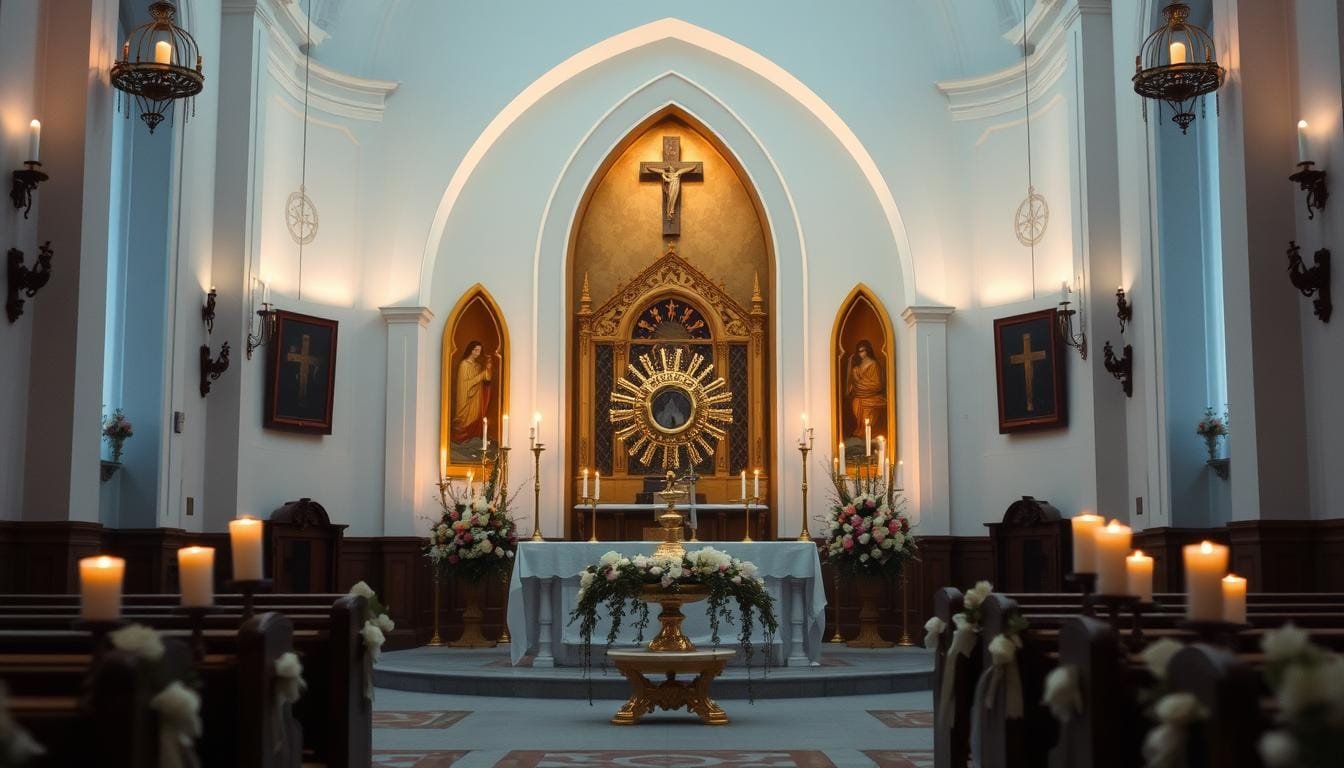Beginner’s Guide to Catholic Eucharistic Adoration
This website contains affiliate links. As an Amazon Associate, I earn from qualifying purchases. The content on this website was created with the help of AI.
Longing for a closer connection with God? Catholic eucharistic adoration might be your answer.
This practice offers quiet time with the Blessed Sacrament, deepening your relationship with Christ.
For beginners, sitting silently before the exposed Eucharist can seem daunting. Many Catholic students initially struggle with staying still and praying during adoration.
Don’t worry! With guidance and tips, you’ll discover its transformative power.
Curious about perpetual adoration or this devotional practice? We’re here to help. Our guide covers the basics and addresses common concerns.
You’ll find practical advice to make your first adoration experience meaningful.
Key Takeaways
- Eucharistic adoration is a powerful way to deepen your relationship with Christ
- It’s normal to feel challenged when first starting adoration
- Perpetual adoration chapels offer flexible opportunities for prayer
- Starting with short periods, like 5 minutes, can help build your adoration practice
- Various prayer methods can enhance your adoration experience
- Consistency and patience are key to developing a meaningful adoration routine
Understanding Catholic Eucharistic Adoration
Catholics believe Christ is truly present in the Eucharist. This belief forms the basis of Eucharistic Adoration. It’s a time to be with Jesus in the consecrated host.
Let’s dive into this beautiful tradition. We’ll explore its significance in our faith journey.
What is the Real Presence?
The Real Presence is a core Catholic belief. It means Jesus is truly present in the Eucharist. Catholics don’t see the blessed sacrament as just a symbol.
They believe it’s the actual Body and Blood of Christ. This doctrine comes from Jesus’ words at the Last Supper. It’s the foundation of our eucharistic prayer.
The History and Significance of Adoration
Eucharistic Adoration has roots in the early Church. It gained popularity during the Middle Ages. Today, it remains crucial in Catholic worship.
St. Clement’s Eucharistic Shrine in Boston practices Perpetual Adoration. For over a decade, the Eucharist has been in constant company of the faithful.
Difference Between Mass and Adoration
Mass and Adoration both focus on the Eucharist, but serve different purposes. Mass is a communal celebration where we receive the Eucharist.
Adoration is a silent, contemplative practice. We spend time with the blessed sacrament, often displayed in a monstrance.
| Aspect | Mass | Adoration |
|---|---|---|
| Purpose | Celebration and reception of Eucharist | Silent worship and contemplation |
| Participation | Communal | Individual or small group |
| Duration | Typically 1 hour | Varies (can be perpetual) |
Knowing these aspects of Eucharistic Adoration deepens our appreciation for it. It’s a powerful form of prayer that strengthens our bond with Christ.
Getting Started with Your First Holy Hour
Your first holy hour can be both exciting and daunting. This guide will help you navigate eucharistic devotion.
Let’s explore expectations, address concerns, and learn proper adoration chapel etiquette.
What to Expect During Adoration
Time might seem to stand still during your first holy hour. You may lose track of time, which is normal. One adorer realized just 3 minutes had passed during her first adoration.
Common Concerns for Beginners
Feeling anxious about your first adoration is natural. You might worry about boredom or not feeling “holy enough”. Remember, simply being present is enough.
Try not to check the time. Focus on your prayer experience instead. As Jesus instructed His Apostles, “Watch and pray.”
Proper Etiquette in the Adoration Chapel
Observing adoration chapel etiquette enhances everyone’s experience. Here are some key points:
- Maintain silence to create a peaceful environment
- Show reverence through gestures like genuflecting
- Avoid distractions to others
- Kneeling is a common posture, but sitting is also acceptable
| Adoration Element | Description | Significance |
|---|---|---|
| Holy Hour | Dedicated hour of prayer in the Presence of the Eucharist | Deepens connection with Christ |
| Grēgoreō | Greek verb occurring 22 times in New Testament | Emphasizes attentiveness to God’s Presence |
| Psalm 139 | Speaks about God searching and knowing individuals | Encourages deep sense of connection during prayer |
Making a holy hour is a valuable prayer, regardless of your personal experience. Many leave feeling peaceful, content, and joyful.
Embrace this time of eucharistic devotion and let it nourish your spirit.
Prayer Methods During Adoration
Eucharistic meditation offers many ways to deepen our spiritual reflection. Let’s explore various methods to enrich your time before the Blessed Sacrament.
Silent Meditation Techniques
Quiet contemplation is key in Eucharistic Adoration. Find a comfortable position and focus on your breath. Let thoughts pass without judgment, centering your mind on Christ’s presence.
This practice helps us listen better to God’s voice. It allows us to be still and open to divine guidance.
Praying the Rosary
The Rosary is a powerful tool for reflection during Adoration. Each bead guides us through Christ’s life mysteries. This deepens our connection to Jesus in the Eucharist.
Scripture Reading and Reflection
Bring a Bible or devotional to your Holy Hour. Read passages slowly, letting the words sink in. The Psalms offer rich material for prayer before the Blessed Sacrament.
Journaling Your Spiritual Journey
Writing during Adoration helps express our thoughts and prayers. Record insights and questions, or simply express gratitude. This creates a record of your spiritual growth.
| Prayer Method | Benefits | Recommended Duration |
|---|---|---|
| Silent Meditation | Enhances focus, deepens listening | 10-15 minutes |
| Rosary | Structured prayer, Marian devotion | 20 minutes |
| Scripture Reading | Biblical insight, divine guidance | 15-20 minutes |
| Journaling | Self-reflection, tracks spiritual progress | 10-15 minutes |

Feel free to switch between these prayer techniques as you feel guided. The aim is to build a deeper bond with Christ through varied forms of Eucharistic meditation.
Overcoming Common Challenges
Eucharistic adoration can be powerful, but it has its hurdles. Many adorers face adoration difficulties like distractions or feeling time drag.
It’s normal to struggle with focus or experience spiritual dryness. Here are some concentration tips to help deepen your adoration practice.
Start with short periods and slowly increase your time. Being present is valuable, even if you don’t feel prayerful. Bring Scripture or spiritual reading to maintain focus during your time with Christ.
Don’t worry about initial difficulties. Many find that regular practice leads to deeper, more meaningful experiences. To fight spiritual dryness, try different prayer methods like silent meditation or journaling.
You might pray the rosary or write about your spiritual journey. These approaches can refresh your adoration time. Daily reflections can also inspire your practice.
“No one eats that flesh unless he adores it” – Saint Augustine
Saint Augustine’s quote reminds us of the link between Eucharistic sacrifice and adoration. This deep truth can motivate us to overcome challenges in our practice.
| Common Challenges | Practical Solutions |
|---|---|
| Distractions | Use a prayer journal to focus thoughts |
| Spiritual dryness | Vary prayer methods (e.g., rosary, scripture reading) |
| Time passing slowly | Start with shorter periods, gradually increase |
| Lack of focus | Bring spiritual reading material |
Use these strategies and be patient with yourself. You can work through adoration difficulties and grow closer to Christ. Eucharistic adoration can become a fulfilling part of your spiritual life.
Making Eucharistic Adoration a Regular Practice
Eucharistic devotion can lead to profound spiritual growth. This form of worship has a rich 1,000-year history. Let’s explore how to make it a consistent part of our lives.
Finding an Adoration Chapel Near You
Finding a nearby adoration chapel is your first step. The Real Presence Eucharistic Education and Adoration Association has a helpful website for locating perpetual adoration chapels.
Not all parishes offer 24/7 adoration. However, many provide regular opportunities for this devotion.

Creating a Consistent Schedule
Consistency is crucial in developing a habit of eucharistic adoration. Start small by committing to weekly or bi-weekly visits. Your devotion may grow, leading to more frequent visits.
Focus on quality time with Jesus, not quantity. This approach will help deepen your practice.
Building a Deeper Relationship with Christ
Regular adoration can significantly strengthen your bond with Christ. Many find healing and spiritual growth through this practice.
Even trauma survivors report finding comfort in the Blessed Sacrament’s presence.
| Benefits of Regular Adoration | Practical Tips |
|---|---|
| Spiritual growth | Start with short visits |
| Inner peace | Bring spiritual reading material |
| Closer relationship with Christ | Keep a prayer journal |
| Increased faith | Try different prayer methods |
Regular eucharistic adoration opens us to transformative experiences. It deepens our spiritual connections and enriches our faith life.
This practice offers a journey of profound personal growth.
Conclusion
Eucharistic adoration is a vital Catholic spiritual practice with numerous benefits. It has a rich history and modern significance.
Over 8,500 U.S. churches offer this devotion, with 800 providing perpetual adoration.
This practice is simple yet powerful. It offers a peaceful refuge from life’s chaos. Many find it to be their week’s highlight, allowing deep connection with Christ.
St. Thomas Aquinas’s hymns have enriched this experience for centuries. They continue to inspire adorers today.
The potential impact of expanded Eucharistic adoration is significant. The Vatican declared 2024 a “Year of Prayer,” making it ideal to start or deepen your practice.
Remember, there’s no “correct” approach to adoration. The key is being present and open to God’s presence.
We encourage you to experience Eucharistic adoration’s transformative power firsthand.













